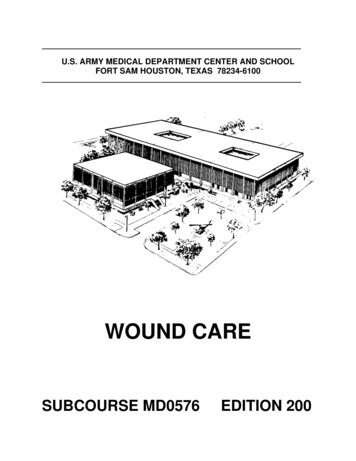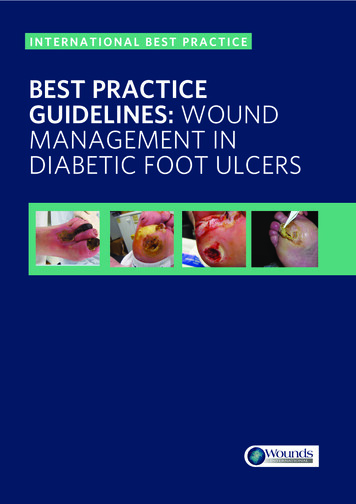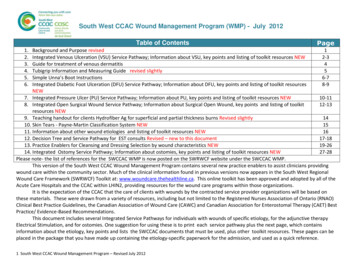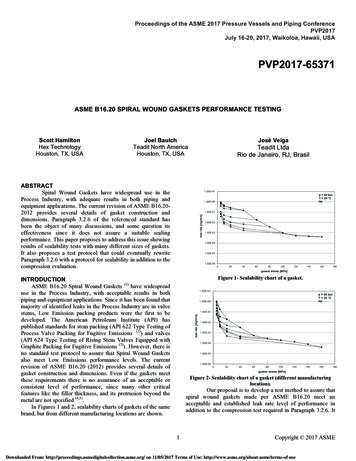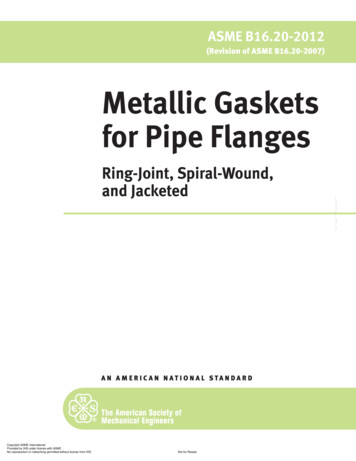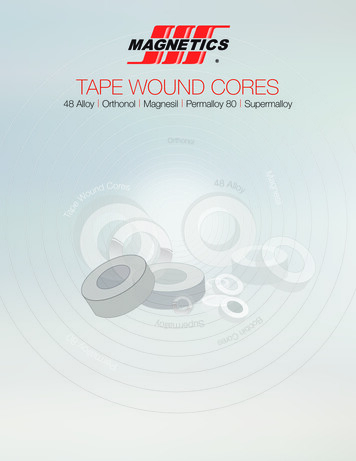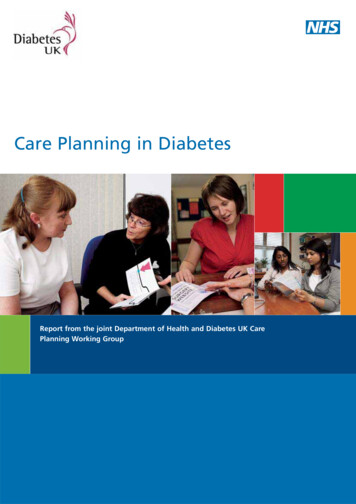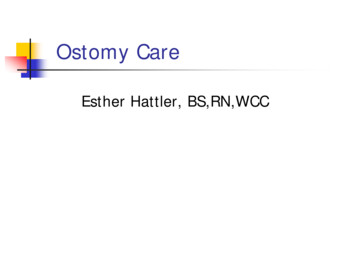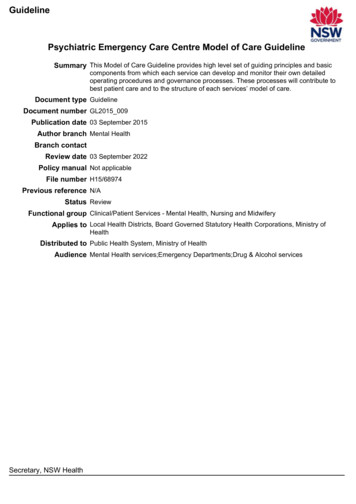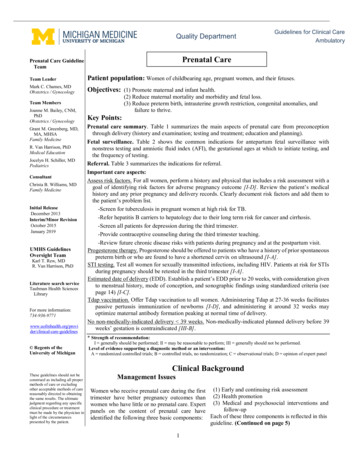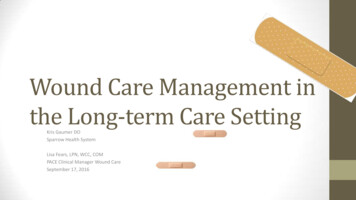
Transcription
Wound Care Management inthe Long-term Care SettingKris Gaumer DOSparrow Health SystemLisa Fears, LPN, WCC, COMPACE Clinical Manager Wound CareSeptember 17, 2016
Objectives1.2.3.Understand the pathophysiology of wounds and wound healing, including the role ofnutrition and sarcopenia.Discern the importance of a wound care team and interdisciplinary team approach towound care in the LTC facility for improved outcomes and cost management.Develop an understanding of evidenced-based wound care and current products availablefor different scenarios of wounds in long-term care and sub-acute rehab environments.
The Guidance of the F-Tag RegardingWound Care F385 Provide adequate physician supervision for wound care F501 Involve the medical director in the wound care program F314 Regulations governing care of pressure ulcers, includingprevention. F309 Quality of care for resident to avoid wounds F157 Notify physician of changes in patient status, including ty-for-MCO-FINAL 000.pdf
Quality Improvement Approaches forWound Care Dr Kim Petrone, et al, at St Anns Community, Rochester NY Wound care team Certified wound specialist (NP or MD) Dietician Nurse Physical therapist During weekly rounds: Defined primary etiology of the wound Created treatment plan Developed facility formulary of product/topical treatments to include onemain product from each broad category of therapiesPetrone, K. Improving Wound Care in Skilled Nursing Facility. JAMDA 15 (2014) B20-B21
Quality Improvement Approaches forWound Care In 18 months: Short stay residents had a decrease from 2.5% to 0.6% of new or worsening pressureulcers Number of high risk residents with pressure ulcers decreased from 9.1 to 5.5% Residents with one or more unhealed pressure ulcer stage 1 or greater decreasedfrom 11.5 to 5.1% Cost for wound products utilized in the facility decreased by 9% in 3 years Caregivers have greater understanding of evaluation and management of complexwounds
Quality Improvement Approaches forWound Care Michelle Coffey, et al, in Texas did a QI for wound care with goal of decreasingwounds by 25% Wound care nurse reviewed all patients with wounds at weekly IDT mtgs Medical director arranged for outside wound care nurse expert to educateteam by rounding with wound care nurse, med director and the two nursepractitioners Reviewing all current wounds General wound care management, products, supplement Weekly wound care rounds with wound care specialist, wound care nurseand advanced practice nurse and intermittently the med directorMichelle Coffey, CNS, RN, MSN, Liam Fry, MD, CMD, Lorena Arce Cardenas, LPN, Wendy Wing, CNS, MSN, RN; and MeganSkinner, MD. Interdisciplinary Approach to Pressure Ulcer Reduction. Quality Improvement/JAMDA 16 (2015) B16-B25
Quality Improvement Approaches forWound Care Wound care nurse accompanied patient to any outside wound care appointments Wound care nurse did all skin assessments for current wounds and also for high riskpatients Early intervention with high risk patientsWeekly IDT meetingsPatient rounds to create individualized treatment plansDaily treatments preformed by wound care nurse
Quality Improvement Approaches forWound Care Results: Nosocomial pressure ulcer prevalence reduced by 63% in 6 months Significant decreases in facility acquired pressure ulcers were seen as soon assix weeks after start of program At 4 months, average prevalence was reduced from 6.5% to 3% or less
Wound Care is a Team Approach Designated wound care nurse – certified through Wound Management organizations Educating staff about wound etiology and management Routine wound rounds with wound care nurse, provider (physician or APP), floornurse, PT/OT, dietitian Involve IDT to heighten awareness and surveillance Involve Medical Director in rounds and wound reports Develop facility formulary for products
Skin Failure: An Emerging Concept Pressure ulcer development a significant predictor of mortality associated with failure of multiple organ systems Reported incidence of pressure ulcers in long-term care varies widely in the literature, ranging from 3.6% to 59.0% in terminally ill nursing home residents is reported as high as 54.7% Pressure ulcers are also a major target for litigation in negligence claims againstnursing homes, second only to falls According to the Agency for Healthcare Research and Quality there are more than17,000 lawsuits related to pressure ulcers annually.Levine, JM. Skin failure: An emerging concept. JAMDA 17 (2016) 666-669
Skin Failure: An Emerging Concept If skin no longer performs its role maintaining vasomotor tone, body temperature, and water balance, andceases protecting the body from infection and mechanical trauma, it can be considered to be failing. Typically not included in the spectrum of multi-organ dysfunction syndrome(involved in up to 80% of all ICU deaths). Recognizing Skin Failure as a clinical syndrome will encourage research improve understanding of why the skin fails (eg pressure ulcers develop)during MOD, sepsis, or end of life conditions.
Skeletal Muscle Impact on Skin Health Skeletal muscle influences energy and protein metabolism throughout the bodyis a primary site for glucose uptake and storagea reservoir of amino acids stored as proteinthese are released when supplies are needed elsewhere in the body. These conditions occur with acute and chronic diseases, which decrease dietary intakewhile increasing metabolic needs. Such metabolic shifts lead to the muscle loss associated with sarcopenia and cachexia,resulting in a variety of adverse health and economic consequences. With loss of skeletal muscle, protein and energy availability is lowered throughout the bodydelayed recovery from illness and slowed wound healingreduced resting metabolic ratephysical disability and poorer quality of lifehigher health care costs.Josep M. Argilés PhD, et al. Skeletal Muscle Regulates Metabolism via Interorgan Crosstalk: Roles in Health and Disease. JAMDA 2016 17, 789-796
Josep M. Argilés PhD, et al. Skeletal Muscle Regulates Metabolism via Interorgan Crosstalk: Roles in Health and Disease. JAMDA 2016 17, 789-796
Nutrition and sarcopeniaJournal of the American Medical Directors Association 2016 17, 789-796DOI: (10.1016/j.jamda.2016.04.019)
Wound Management Team approach for wound careSkin Failure as a concept of organ failureSkeletal muscle contributing to skin health or failureWound care in the facility -- approach, products, developing planof care
Wound ManagementUpdates in CareLisa Fears, LPN, WCC, COM, PACE Clinical Manager Wound CareKris Gaumer DO
As of April this year the National PressureUlcer Advisory Panel (NPUAP) announced achange in terminology from pressure ulcer topressure injury and updated the stages ofpressure injury.
So what changed The term “pressure injury” replaces “pressure ulcer” in the National PressureUlcer Advisory Panel Pressure Injury Staging System.The change in terminology more accurately describes pressure injuries toboth intact and ulcerated skin.
In the previous staging system Stage 1 and Deep Tissue Injurydescribed injured intact skin, while the other stages describedopen ulcers.This led to confusion because the definitions for each of thestages referred to the injuries as “pressure ulcers”.
In addition to the change in terminology, Arabic numbers arenow used in the names of the stages instead of Romannumerals.Instead of stage I, II,III, and IV, it’s now as simple as 1,2,3,4.
The term “suspected” has been removed fromthe Deep Tissue Injury diagnostic label.
Additional pressure injury definitions agreed upon atthe meeting included:o Medical Device Related Pressureo Mucosal Membrane Pressure Injury
New definition of a Pressure InjuryA pressure injury is localized damage to the skin and/or underlying soft tissueusually over a bony prominence or related to a medical or other device.The injury can present as intact skin or an open ulcer and may be painful.The injury occurs as a result of intense and/or prolonged pressure or pressurein combination with shear.The tolerance of soft tissue for pressure and shear may also be affected bymicroclimate, nutrition, perfusion, co-morbidities and condition of the softtissue.
Stage 1 Stage 1 Pressure Injury: Non-blanchableerythema of intact skin Intact skin with a localized area of non-blanchableerythema, which may appear differently in darklypigmented skin. Presence of blanchable erythema or changes insensation, temperature, or firmness may precedevisual changes. Color changes do not include purple or maroondiscoloration; these may indicate deep tissuepressure injury.
Stage 2 Stage 2 Pressure Injury: Partial-thickness skin losswith exposed dermis Partial-thickness loss of skin with exposed dermis The wound bed is viable, pink or red, moist, and may alsopresent as an intact or ruptured serum-filled blister Adipose (fat) is not visible and deeper tissues are notvisible Granulation tissue, slough and eschar are not present These injuries commonly result from adversemicroclimate and shear in the skin over the pelvis andshear in the heel This stage should not be used to describe moistureassociated skin damage (MASD) including incontinenceassociated dermatitis (IAD), intertriginous dermatitis(ITD), medical adhesive related skin injury (MARSI), ortraumatic wounds (skin tears, burns, abrasions).
Stage 3 Pressure Injury: Full-thickness skin loss Full-thickness loss of skin, in which adipose (fat) is visiblein the ulcer and granulation tissue and epibole (rolledwound edges) are often presentSlough and/or eschar may be visibleThe depth of tissue damage varies by anatomicallocation; areas of significant adiposity can develop deepwoundsUndermining and tunneling may occurFascia, muscle, tendon, ligament, cartilage and/or boneare not exposedIf slough or eschar obscures the extent of tissue loss thisis an Unstageable Pressure Injury
Stage 4 Pressure Injury: Full-thickness skinand tissue loss Full-thickness skin and tissue loss with exposed or directlypalpable fascia, muscle, tendon, ligament, cartilage or bone inthe ulcerSlough and/or eschar may be visibleEpibole (rolled edges), undermining and/or tunneling oftenoccurDepth varies by anatomical locationIf slough or eschar obscures the extent of tissue loss this is anUnstageable Pressure Injury
Unstageable Pressure Injury: Obscured fullthickness skin and tissue loss Full-thickness skin and tissue loss in which the extent of tissuedamage within the ulcer cannot be confirmed because it isobscured by slough or escharIf slough or eschar is removed, a Stage 3 or Stage 4 pressureinjury will be revealedStable eschar (i.e. dry, adherent, intact without erythema orfluctuance) on the heel or ischemic limb should not be softenedor removed
Deep Tissue Pressure Injury:Persistent non-blanchable deepred, maroon or purplediscoloration Intact or non-intact skin with localized area of persistentnon-blanchable deep red, maroon, purple discoloration orepidermal separation revealing a dark wound bed or bloodfilled blister.Pain and temperature change often precede skin colorchanges.Discoloration may appear differently in darkly pigmentedskin.This injury results from intense and/or prolonged pressureand shear forces at the bone-muscle interface.The wound may evolve rapidly to reveal the actual extent oftissue injury, or may resolve without tissue loss.If necrotic tissue, subcutaneous tissue, granulation tissue,fascia, muscle or other underlying structures are visible, thisindicates a full thickness pressure injury (Unstageable, Stage3 or Stage 4).Do not use DTPI to describe vascular, traumatic, neuropathic,or dermatologic conditions.
Medical Device Related Pressure Injury - describes an etiology.Medical device related pressure injuries result from the use of devices designed and applied for diagnostic or therapeutic purposes. Theresultant pressure injury generally conforms to the pattern or shape of the device. The injury should be staged using the staging system.
cerTraining/module1/MucousMembrane1.aspxMucosal Membrane Pressure Injury:Mucosal membrane pressure injury is found on mucous membranes with a history of a medical device in use at the locationof the injury. Due to the anatomy of the tissue these injuries cannot be staged.
So why a Wound Care Nurse?
What does a wound nurse do?They are your detective to the wound
CNAobserveswoundStaff nurseassessStaff nursealertswoundnurseDr. notified oftreatment planWoundreportshared withIDT Care planadjusted andupdated Careconference toreview withresident andfamily members
Wound NurseTherapyDieticianSocial Work
The wound nurse documents a snap shot of what is in the wound and influencing the wound.This is the information the IDT needs to further treat the resident. not just the hole in theresident CORRECT Anatomical locationSlough %Eschar %Granulation %EpithelializationSize L x W x D in Surrounding tissue: Color, edema, firmness, intact, induration,pallor, lesions, texture, scar, rash, staining, moistureany indicators of infection: fever, streaking, redness, increaseddrainage, odor, warmth, elevated WBC, induration, malaise,edema, weeping, increased pain, discolorations Any incontinence influencesADL’s influencing the wound (is he resident up all day)WAS THIS WOUND PRESENT ON ADMISSION or FACILITYAQUIREDWound etiology (pressure injury or otherwise) Partial or fullthicknessPain . location, causative factors, intensity, quality, duration,alleviating factors, patterns, variations, interventionsInterventions for healing: dietary supplements, vitamins, labtests, turning repositioning schedules, support surface, cushion,Additions of padding, pillows, elevation, heel protection,incontinence management, skin protection(barrier ointments)Any conditions which would affect healing: Mobility/TurningSurface and Positioning Limitations, Nutritional Status,continence,Notation of abnormal labs, infections, deterioration of medicalcondition, non-compliance.Documenting current topical treatment plan, response to tx,modifications to plan, implementation of new orders, reason fornot changingtreatment plan, referrals if neededResident, family and caregiver education.
Case Study Lower Extremity Background VC is a 74-year-old female with history of chronic DVTfollowing surgery on her hip eight years ago for the last five years has suffered from edema whichworsens during the day VC is now moved into your LTC nursing facility andspends most of her day sitting in her recliner in herroom. Wound History On initial assessment the patient suggested that herwound was the result of an insect bite three years ago,which never really healed. She was treating it herself with a cream her sister gaveher but over the last six months the wound has becomelarger, more painful and smelly, exuding large amountsof fluid. You have been called in to assess the wound and treatthe patient. What is your treatment plan?
Case Study Diabetic Ulcer Background FJ is 65 years old and resides in a LTC facility. He has poor vision and limited mobility becausehis hips are painful. He was diagnosed with Type II diabetes threeyears ago and has been poorly maintained onoral hypoglycemic medications prior to coming toreside in a LTC setting. FJ had been treating the wound himself for 3months by bathing it in salt and water. Wound History On initial assessment the patient had a large,necrotic wound on the base of his right big toe. The wound was painless and dry. The skin at the base of the toe was red. You have been called in to assess the wound andtreat the patient. What is your treatment plan?
Case Study Pressure Injury BT is a 76 year old female who has just moved intoyour LTC facility.She is 5’4” and 100 lbs.She has the following medical diagnoses: COPD, HXCVA on the right side, and HTN.BT becomes fatigued during meals and her intake isusually less than 50%.She is continent of bowel but occasionally incontinentof urine and requires her underclothing changed onceor twice daily.Due to fatigue and paralysis she needs weight bearingassist to reposition when she is in bed or wheel chair,although she can move from side to side somewhat.BT has some limited perception of pressure but whenshe is uncomfortable she can express her discomfort.She uses 2 liters of oxygen via n/c and has hadbreakdown behind her ears before.BT can walk with a walker for distances less than 5 feetbut uses a wheel chair the majority of the time.The CNA was changing BT and observed this wound onher buttock.What is your treatment plan?
Case Study Pressure Injury Mr Jones is an 86 y/o maleadmitted to the hospital twodays ago with dehydration,malnutrition and dementia. You are coming on shift andmaking rounds. You assess hisskin and note redness on hissacrum and heels. He is incontinent of both urineand feces and cannot movehimself around in bed. What is the tx plan?
Case Study Trauma Wound This 82 y.o. female caught her leg on theedge of a wall in the facility greenhouse, which resulted in an open woundto the medial side of her left calfmeasuring 3.0 cm x 1.5 x 0.2 cm. The exudate being produced by thewound is so copious that it is runningdown her leg. The resident’s has a history of chronicvenous insufficiency and clinical signsof venous disease. There is chronic edema influences, noactive infection, and the resident wantsto remain up and put of her room allday at activities. What is the treatment plan?
Knowing what to put on the woundWhenever you have a wound, whether it’s a minor cut or a majorincision, it’s crucial to care for it properly.Part of the process includes wound care dressings. There are a variety ofoptions when it comes to dressings, and to determine which is the bestand most effective depends on what sort of wound you have.If its too wet-dry itIf its too dry-add moistureIf its inflamed and irritated-soothe itIf its chronic-irritate it to stimulate itIf its palliative-provide comfort and symptom control
Topical Wound Management Non adherent dressings Debriding agents Antimicrobial Charcoal Liquid Barrier Gauze based Silver coated dressings Biologic NPWT Calcium Alginates Collagen Dressings Composite dressings Contact Layer dressings Foam dressings Hydrocolloid Dressings Hydrogel dressings Transparent films
HydrogelFoam
Calcium AlginateCollagen
Liquid BarriersContact Layer
AntimicrobialsSilver coated
HydrocolloidalGauze
Composite dressingOcclusive making moistureproof tape
Negative Pressure WoundTherapy
Moisture Barriers and Moisturizers
Enzymatic DebriderVasolex Ointment
Silicone padding to pressure areas hard tofit
Buttocks “shear” Is it pressure ?Kyphosis Vertebrae
Sacral coccyx region, heels and toes
So, why a wounds care nurse?As you can see they are your detective to the wound.They can help determine the etiology, the best evidencedbased treatment product, and is the link to the IDT team.A wound nurse can help determine how the treatment planwill affect the resident’s ADL’s with the goal for the resident tostill maintain their highest quality of life while residing in yourfacility, their home.
What are the residents and families concerns?Is the wound new or old?Can this wound resolve with the products the facility ha available to use?What co-morbid influences are there on the wound?How is the residents nutritional status?What issues if any could interfere with the goal toward wound re
Lisa Fears, LPN, WCC, COM PACE Clinical Manager Wound Care September 17, 2016 . Objectives 1. Understand the pathophysiology of wounds and wound healing, including the role of . six weeks after start of program At 4 months, average prevalence was reduced from 6.5% to 3% or less . Wound

